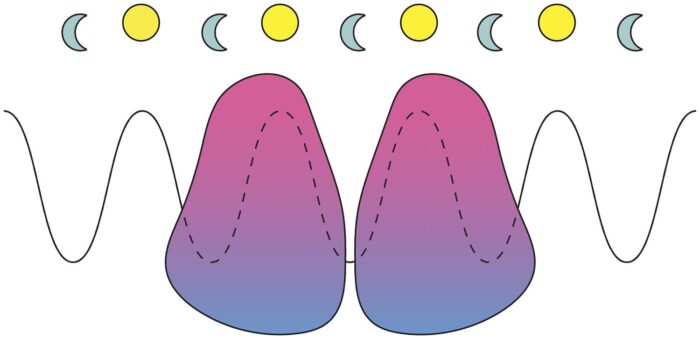Two sub-populations of cells in the suprachiasmatic nucleus create a signalling axis that generates the properties required of a master body clock

Our behaviour, and the functions of our cells, follow a daily cycle in line with the 24-hour day. This is centrally coordinated by the body’s master clock, known as the suprachiasmatic nucleus (SCN). However, how the properties required of a strong clock emerge from the network of cells that make up the SCN has been unclear. Michael Hastings’ group in the LMB’s Neurobiology Division has now identified a signalling axis that acts as a pacemaking hub of the SCN to control these required properties.
Although many of the cells in our bodies have their own local clocks, the principal circadian clock is the SCN, a network of approximately 20,000 cells in the hypothalamus. The SCN is unique in its ability to generate and maintain robust and precise circadian rhythms, with all other clocks synchronised by the SCN.
Importantly, the circadian oscillations of the SCN can persist indefinitely, even when the tissue is cultured in a dish ex vivo. However, if the tissue is separated into single cells, coherence is lost, demonstrating that the properties that make the SCN such a powerful clock emerge from the way in which the component cells interact with each other. Although the cycles are synchronised in these cells, waves of activation are created by slightly staggered phases of oscillations in a distinct sequence across different regional cell groups. This has been thought to be important in broadcasting distinct signals to different parts of the brain at specific times, but it was unclear how this is controlled.
Neurons in the SCN can be defined on the basis of the different signalling neuropeptides they produce or respond to as well as anatomical location, allowing scientists to delineate distinct compartments. For example, one sub-population of cells can be defined by their production of the neuropeptide VIP (vasoactive intestinal polypeptide) and another on the basis of their expression of the receptor for VIP, VPAC2.
Andrew Patton, and other members of Michael’s group, decided to investigate these two sub-populations because VIP was known to be integral for SCN timekeeping via interaction with VPAC2, but it was not clear how signalling between these cell-types might be related to network level properties of the master clock.
Using a variety of techniques that allow manipulation of specific cells in the tissue and molecular dissection of the roles of different groups of cells and of specific proteins, the team were able to characterise cells that express VIP or VPAC2 as separate sub-populations with different anatomical distributions, and distinct electrical and neurochemical properties. When working together, these two cell populations are able to control the rhythmicity, period, and phase of circadian oscillations in the SCN as well as generating spatiotemporal complexity, creating the waves of activation across the clock. This demonstrates that this signalling axis between these two sub-populations of cells is a pacemaker hub that generates the properties that makes the SCN a powerful clock.
Circadian rhythms are vital for health and wellbeing, with dysfunction underlying a large range of neuropsychiatric disorders, cancers, and metabolic diseases. Furthermore, the body clock is put under stress by features of modern life such as shift-working and jetlag. Understanding the mechanisms that underpin circadian systems in our bodies will be necessary for any clinical interventions that might help our bodies cope better under these pressures.
The work was funded by UKRI MRC and BBSRC.
Further references
The VIP-VPAC2 neuropeptidergic axis is a cellular pacemaking hub of the suprachiasmatic nucleus circadian circuit. Patton, AP., Edwards, MD., Smyllie, NJ., Hamnett, R., Chesham, JE., Brancaccio, M., Maywood, ES., Hastings, MH. Nature Communications 11: 3394
Michael’s group page